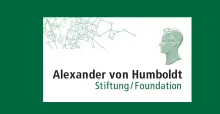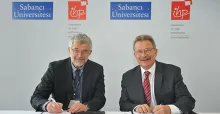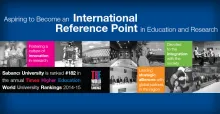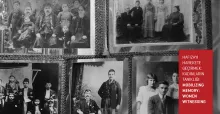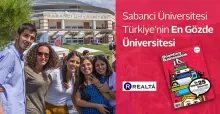Sabancı University and the leading German scientific center IHP-Microelectronics establish a first in Turkey: the Microelectronics – Joint Virtual Excellence Lab based on the “More-than-Moore” concept.

The Microelectronics Research Group of the Sabancı University Faculty of Engineering and Natural Sciences and the leading German scientific center IHP-Microelectronics join their scientific experience and resources in a Microelectronics – Joint Virtual Excellence Lab based on the “More-than-Moore” concept.
The Microelectronics Research Group of the Sabancı University Faculty of Engineering and Natural Sciences has been undertaking successful cooperation projects with the leading German scientific center IHP-Microelectronics since 2008. The two cutting-edge institutions now join their scientific experience and resources in a Microelectronics – Joint Virtual Excellence Lab based on the “More-than-Moore” concept. This initiative is expected to take scientific studies to a new level that is novel to Turkey and rare abroad as well, leading to more effective studies both in Turkey and on a European level. The motto of the More-than-Moore concept is to develop smaller, functional, economical, versatile and long-lasting electronic systems. This has potential to contribute to many industries including communication, biomedicine, aerospace, aviation, security, automotive and robot-automation.

The lab was established at the signing ceremony and conference held at the SUNUM facility on the Sabancı University Tuzla campus on Thursday, October 16, 2014, hosted by Sabancı University President Professor Nihat Berker and attended by IHP-Microelectronics Rector Professor Bernd Tillack, the German Federal Ministry of Education and Research, and representatives from the Turkish Ministry of Science, Industry and Technology, TÜBİTAK, and related sectors.
The research and development-focused cooperation of IHP-Microelectronics, a major technology provider to the leading wireless communication companies of the world, and Sabancı University is the first example of a pioneering model in Turkey. The IHP - Sabancı University Joint Virtual Lab – Center of Excellence will enable easier access of other universities, research institutions and companies in Turkey to research and development in the field, serving to increase cooperation.
The projects in the Center of Excellence will be particularly useful to the electronics and communication, health (biomedical), satellite-aerospace, aviation, security, automotive, robot-automation and environmental industries. The social benefit aspect of the cooperation and resulting projects will be safer, healthier, more economical and environmentally-friendly project outputs.

The objectives of the Sabancı University and IHP-Microelectronics Joint Virtual Excellence Lab are:
Extending the research capabilities by using a complementary research approach; strengthening the position for joint project applications; increasing international visibility; attracting excellent students and researchers for joint project work; and bringing in high level teaching (lectures, internships at IHP, and visiting scientists) based on advanced IHP and Sabancı’s research topics.
Supported by the technological infrastructure and knowhow of Sabancı University and IHP-Microelectronics, the ‘Center of Excellence’ will help to demonstrate successful German Turkish cooperation on scientific as well as political levels.
"It is our goal is to strengthen the cooperation between Turkey and Germany in the fields of science and research. Therefore, I expressly welcome the special commitment of the IHP-Leibniz Institute for Innovative Microelectronics in Frankfurt (Oder) and the technological cooperation with its partner in Istanbul. I wish both partners every success in their cooperation," said the Federal Minister of Education and Research, Johanna Wanka. "This cooperation reflects the aim of the German-Turkish Year of Science 2014, namely the further expansion of joint activities in research, education and innovation with projects that point the way to the future."
IHP Scientific Director Professor Bernd Tillack said: “The Joint Lab is targeting on topics which offer us the opportunity to do research on a high level and deliver results with large social impact in both countries. For this research both partners bring in complementary research concepts. That evokes important synergy effects and creates a win-win situation. This will attract highly motivated young people for our research projects, another important advantage of working together with Sabancı University. We regularly have a group of students from Sabancı working in IHP for a couple of months every year. The Joint Lab with its very attractive and exciting research topics will help both of us to attract even more highly motivated students in the future.”
Sabancı University - IHP Microelectronics cooperation track record since 2007:
The cooperation between the two institutions started in 2007 based on mutual topics of interest defined under a Memorandum of Understanding. The model of cooperation includes scientific exchange of ideas, scientist/student exchanges, and sharing facilities and services. As a result of the cooperation, there are 4 Sabancı University graduates (BSc, MSc and PhD level) working as a full-time researhers at IHP. Researchers from the two institutions make at least 3 joint publications per year. Other outputs include more than 5 successfully completed, on-going or under evaluation sponsored projects from Turkish, German and EU funding Agencies/schemes, along with more than 20 jointly-published journal and conference papers from these project outputs, more than 5 graduate students’ dissertations, over 15 undergraduate graduation projects and internship opportunities for over 15 students.
About Sabancı University
Sabancı University was established in 1999 as Turkey’s first university without departments, and enables students to choose their diploma programs at the end of their first year. Sabancı University is the first university to host the global leaders in sustainability and sign the United Nations Global Compact. Sabancı University was at the top of the "University Innovation and Entrepreneurship Index" compiled by the Turkish Ministry of Science, Industry and Technology in 2012, 2013 and 2014, and is also the first Turkish private university to be included in the top 200 (182nd place) of the Times Higher Education (THE) 2014 Rankings. Furthermore, Sabancı is among the top 500 of the QS 2014 World University Rankings. http://www.sabanciuniv.edu/
About the Sabancı University Faculty of Engineering and Natural Sciences Microelectronics Research Group
Led by Professor Yaşar Gürbüz, the Sabancı University Microelectronics Research Group conducts
research and development of CMOS and SiGe-BiCMOS based integrated devices, circuits and system solutions, MEMS, detectors/sensors & actuator solutions for wireless communication, biomedical and medicine, surveillance and security, aerospace and industrial applications. The Group also has micro and nanofabrication capabilities provided by Sabancı University Nanotechnology Research and Application Center (SUNUM). http://microsystems.sabanciuniv.edu/
About IHP-Microelectronics
The IHP is an institute of the Leibniz Association and conducts research and development of silicon-based systems and ultra high-frequency circuits and technologies including new materials. It develops innovative solutions for application areas such as wireless and broadband communication, aerospace, biotechnology and medicine, automotive industry, security technology and industrial automation. The IHP employs approximately 300 people. It operates a pilot line for technological developments and the preparation of high-speed circuits with 0.13/0.25 µm BiCMOS technologies, located in a 1000 m² class 1 cleanroom. http://www.ihp-microelectronics.com/en/start.html
By Melek Sarı





